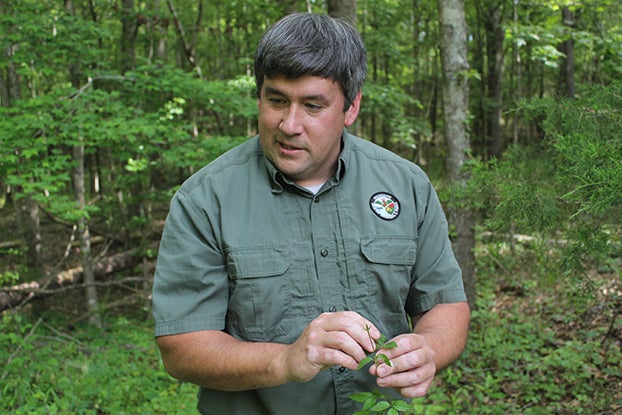Habitat Management starts with a simple site visit
Published 9:40 am Thursday, May 25, 2023

- John Gruchy explains how one can see where deer browsed on vegetation in a food plot on a recent private lands site visit in Lincoln County. Gruchy is the private lands program director for the Mississippi Department of Wildlife, Fisheries and Parks. (Hunter Cloud | The Daily Leader)
|
Getting your Trinity Audio player ready...
|
BROOKHAVEN — Habitat management is one of the easiest ways private landowners can have an impact on the turkey populations, and any wildlife population, in our state. The United States Department of Agriculture Forest Inventory and Analysis Program reported in 2021 that 88.64 percent of the forested land in Mississippi is privately owned.
While Mississippi Department of Wildlife, Fisheries and Parks can make recommendations to change the length of season to aid hunter success, require physical tags to crack down on poaching and eliminate the fall season to increase hen survival. Private land management will be the key to the future of turkey hunting.
Landowners, hunters, habitat managers and wildlife enthusiasts do not have to tackle the habitat problem on their own. MDWFP offers a private lands program which offers technical guidance for people to develop and execute a habitat management plan best suited for their property.
Private lands program director John Gruchy walked out into a field in Lincoln County and started to piece together a puzzle for management and habitat needs for a recent private land site visit. He stopped and listened to the birds in the area, some indicative of closed canopy forests and others associated with old fields in early plant succession.
Turkey program director Adam Butler accompanied him as he explained the importance of habitat diversity. Wild turkeys need early successional cover for nesting and brood cover early in their life but an adult gobbler prefers more open hardwoods so he can see predators.
“It is a sweet spot. You have to hit the right point of early succession and hardwoods,” Butler said. “If you go all in on brood or nesting cover you won’t have anywhere to hunt turkeys. You have to also learn what is the limiting factor. The most limiting factor on the landscape is habitat for nesting and brooding.”
Fortunately for landowners in Southwest Mississippi, old cow pastures are already great candidates for natural brooding and nesting cover. One challenge Gruchy said people encounter is the thick carpet of pasture grasses. A poult needs to be able to walk on bare dirt, not a thick understory of pasture grass such as bahia grass.
Disking, fire and herbicide treatments are one way people can maintain early successional plants in an old field management setting. Upland mixed timber stands have been hammered in timber cutting over the past 50 years and forest data shows Loblolly pines now dominate the region in forest makeup. Lincoln County is 73.4 percent forested according to the Mississippi Forestry Commission.
Mixed timber stands can be great habitat for turkeys. Butler said when a turkey becomes an adult it becomes an area they like to hang out because they can look out for predators and gobblers can strut and show off for hens.
“If you go back 40-50 years before the 1980s, most of Mississippi was farming land and a lot of farm ground became forested as farmers retired. If you walk away from a mixed stand for 30 years open hardwoods is what you would end up with,” he said. “We have had a transition in land use towards pine plantations. You can have good turkey woods in pine plantations but you have to make it good. You have to thin and burn with pines. It requires more active management. You will have to be intentional.”
In the big picture, aforestation may not be needed depending on the scale of the property and habitat around you. Gruchy said the challenge comes in when people are wanting to manage timber and wildlife.
A private lands visit can help provide guidance into how your property fits into the surrounding landscape. It boils down to a person’s goal in management and the biologists then make decisions to maximize the property’s potential.
Those interested in a land visit should have a few things prepared. Satellite imagery of the property and the surrounding area and understanding of the recent history of the property. Gruchy asked questions about how frequently the old field was disturbed, if cows would have grazzed in some sections and what the lumber harvest would have been like.
Private land biologists are helpful in looking at the land in a different lens. Gruchy walked around a food plot pointing out where deer had foraged on beauty berries and perennial wildflowers, something an untrained eye would not catch. He pointed out early successional plants growing after a fire on a hillside including a pawpaw plant growing, the charred soil underneath its canopy.
Each property will have different recommendations depending on the goals and needs of managers. Gruchy said on this particular property in Lincoln County that thinning some of the midstory canopy to get more sunlight on the ground would encourage more browsing cover, the old field needed an annual disturbance to keep it in early succession for brooding and nesting cover while the pasture grass needed to be sprayed.
He also had a recommendation for a 10 acre cow pasture now grown up with sweetgums. It was way past the point of being brush hogged. Gruchy said a cost share program could actually aid a landowner in getting a grown up field sprayed via helicopter. The US government offers a plethora of cost share programs but biologists with MDWFP can aid landowners in finding the one that is the best fit for their management needs.
It is not too late to start managing habitat for turkeys, deer and whatever else one hopes to accomplish but it might take some time. Site visits are complimentary from the MDWFP and one can simply request one by visiting MDWFP.com/wildlife-hunting/private-lands-program and clicking on request a site visit.
“People might say ‘oh I want to see it as if man hadn’t touched it.’ Well we already have bothered nature,” Gruchy said. “It is too late, that ship has sailed. Now all we can do is try to manage the land to meet our objectives.”





